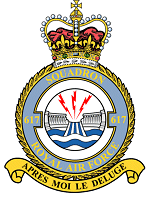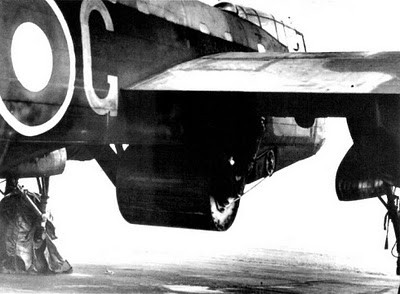
The Aircraft
 The aircraft used by 617 Squadron on the
Dams Raid were special adaptations of the basic Avro Lancaster
BIII known as the Type 464 Provisioning.
The aircraft used by 617 Squadron on the
Dams Raid were special adaptations of the basic Avro Lancaster
BIII known as the Type 464 Provisioning.
Modifications
included the removal of the Fraser Nash FN50 power operated mid
upper turret together with its associated equipment and ammunition.
The bomb doors together with the internal bomb racks were removed
and fared over fore and aft
In place of the bomb bay, a recess was
created in which the bomb was held between a pair of V-shaped
side-swing calliper arms each fitted with a 20" diameter discs, which
corresponded to two circular tracks, one at each end of the bomb.
Back spin was imparted to the bomb by friction generated between the
driven discs and the circular tracks on the bomb. The
power to spin the bomb was provided by a Vickers-Jassey motor
driving a belt running in a groove of the starboard driven
disc. Hydraulic power originally used to power the mid-upper
turret and bomb-bay doors was diverted to a hydraulic motor on the
fuselage floor. As the front gunner had to be in his turret
during the attack to deal with flack guns on the dams stirrups were
fitted to make him more comfortable and to keep his feet out of the
bomb-aimers way.
A pair of spot lamps mounted one under the nose
and the other in the belly were designed to point downwards and to
the port side, where the Navigator looking through the cockpit
blister could see them shinning on the surface of the water.
When the pools of light formed a figure of eight the aircraft was at
exactly 60 feet.
On the advice of Flt/Lt Bone of the Radio
Department of the Royal Aircraft Establishment (RAE) at Farnborough
a final modification involved the installation of VHF Type 1143
radio sets, to improve communication between the aircraft when
operating at low level. The use of this type of radio enabled
Gibson to direct the attack, which in turn led to the subsequent
development of the role of Master Bomber, whose job it was to direct
the bombing of a main force attack and keep it on the aiming point.
The drive belt can be clearly seen in the
accompanying photograph of Wing Commander Guy Gibson's Lancaster
ED932/G, AJ-G. The /G indicates that the aircraft should be
kept under guard when on the ground. The covers over the
wheels are to protect the tyres from oil dropping from the engines
above.
The other dimension of the standard Lancaster BIII are as follows:
| Crew | 7: pilot, flight engineer, navigator, bomb aimer, wireless operator, mid-upper and rear gunners |
| Length | 69 ft 5 in (21.18 m) |
| Wingspan | 102 ft (31.09 m) |
| Height | 19 ft 7 in (5.97 m) |
| Wing Area | 1,300 ft² (120 m²) |
| Empty Weight | 36 828 lb (16,705 kg) |
| Loaded Weight | 63,000 lb (29,000 kg) |
| Power plant | 4× Rolls-Royce Merlin V12 engines, 1,280 hp (954 kW) each |
| Maximum Speed | 240 kn (280 mph, 450 km/h) at 15,000 ft (5,600 m) |
| Range | 2,700 nmi (3,000 mi, 4,600 km) with minimal bomb load |
| Service Ceiling | 23,500 ft (8,160 m) |
| Wing Loading | 48 lb/ft² (240 kg/m²) |
| Power/Mass | 0.082 hp/lb (130 W/kg) |
| Guns | 8 x 303 Browning machine guns in three turrets. (Type 464 6 guns in two turrets. The mid-upper turret was removed) |
| Bomb Load | Maximum normal load 14,000 lb or 22,000lb with modifications |